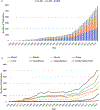An epidemiological introduction to human metabolomic investigations
- PMID: 37468430
- PMCID: PMC10527234
- DOI: 10.1016/j.tem.2023.06.006
An epidemiological introduction to human metabolomic investigations
Abstract
Metabolomics holds great promise for uncovering insights around biological processes impacting disease in human epidemiological studies. Metabolites can be measured across biological samples, including plasma, serum, saliva, urine, stool, and whole organs and tissues, offering a means to characterize metabolic processes relevant to disease etiology and traits of interest. Metabolomic epidemiology studies face unique challenges, such as identifying metabolites from targeted and untargeted assays, defining standards for quality control, harmonizing results across platforms that often capture different metabolites, and developing statistical methods for high-dimensional and correlated metabolomic data. In this review, we introduce metabolomic epidemiology to the broader scientific community, discuss opportunities and challenges presented by these studies, and highlight emerging innovations that hold promise to uncover new biological insights.
Keywords: epidemiology; high-dimensional statistical methods; integrative omics; metabolites; metabolomic epidemiology; quality control.
Copyright © 2023 Elsevier Ltd. All rights reserved.
Conflict of interest statement
Declaration of interests None declared by authors.
Figures



References
Publication types
MeSH terms
Grants and funding
LinkOut - more resources
Full Text Sources

